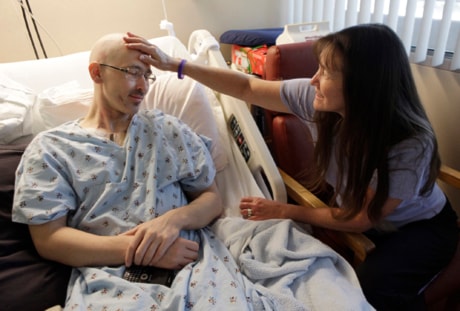HAYWARD, Calif. — If Nick Glasgow were white, he would have a nearly 90 per cent chance of finding a matching bone marrow donor who could cure his leukemia.
But because the 28-year-old bodybuilder is one-quarter Japanese, his doctor warned him the outlook was grim. Glasgow’s background would make it almost impossible to find a match, which usually comes from a patient’s own ethnic group.
The doctor “didn’t say it was slim-to-none. He didn’t say it would be hard. He said ‘zero chance,”’ Glasgow’s mother, Carole Wiegand, recalled with tears in her eyes. “When Nick heard that, it sent him plummeting.”
At a time when the number of multiracial North Americans is rising, only a tiny fraction of donors on the U.S. national bone-marrow registry are of mixed race. The National Marrow Donor Program is trying to change that by seeking more diverse donors for patients suffering from leukemia, lymphoma and other blood diseases.
“The truth is, when people of different backgrounds marry and produce offspring, it creates more types that are harder to match,” said Michelle Setterholm, the program’s director of scientific services. “The probability just gets lower when you have people of mixed ancestral DNA.”
The number of people who identify themselves as multiracial in the United States has grown from 3.9 million in 2000, the first year the census included the category, to 5.2 million in 2008. Mixed-race people account for 1.6 per cent of the U.S. population.
The donor program has been pushing for years to recruit more racial minorities and mixed-race donors. So far, multiracial volunteers make up just three per cent of the seven million people on the registry.
That is higher than the percentage of mixed-race people in the U.S. But there are so many possible racial and ethnic combinations that finding a match can still be extremely difficult.
The reason that mixed-heritage patients are so hard to match can be found in the immune system.
Populations in different parts of the world developed certain proteins, or markers, that are part of the body’s natural defences. These markers help the immune system determine which cells are foreign and should be rejected.
A match between two people who share many markers will reduce the risk of the donor and recipient cells attacking each other. Because certain markers tend to cluster in particular ethnic groups, matches are most often found among people of shared backgrounds. Multiracial patients often have uncommon profiles and a much harder time finding a donor.
About 6,000 patients in the U.S. are awaiting a bone marrow match.
Finding compatible organs for transplant is simpler. Organ matches rely essentially on blood type, which is not related to race.
Glasgow’s grandfather, an Army soldier from South Carolina, fell in love while stationed in Japan after the Second World War and married across racial lines at a time when it was illegal to do so in many states.
From his Japanese grandmother, Glasgow got cell markers that set him apart from most other whites. From his white grandparents, he got markers that set him apart from other Japanese.
Geary Moya’s background — part Navajo, part Mexican — has kept his life on hold since 2005, when he was diagnosed with non-Hodgkin’s lymphoma. Chemotherapy has put his cancer in remission, but a bone marrow transplant is his only hope for a cure.
“I can’t work. I can’t plan. I just don’t know what tomorrow will hold for me,” said Moya, a 51-year-old former manager of an appliance company.
He often visits bone marrow drives, where he tries to encourage prospective donors to sign up.
“If it’s not for me, it’ll help someone,” he said last week as he stopped by a booth registering potential bone marrow donors at California State University in Hayward. “There’s a whole list of people out there waiting for someone to come along.”
Moya watched and answered questions as a trickle of students filled out forms with their health history and ethnic makeup before swabbing the inside of their cheeks to collect the genetic material that will be used to match them to waiting patients.
If a match is found, they will undergo a painful procedure in which doctors withdraw liquid marrow from the back of their pelvic bones.
